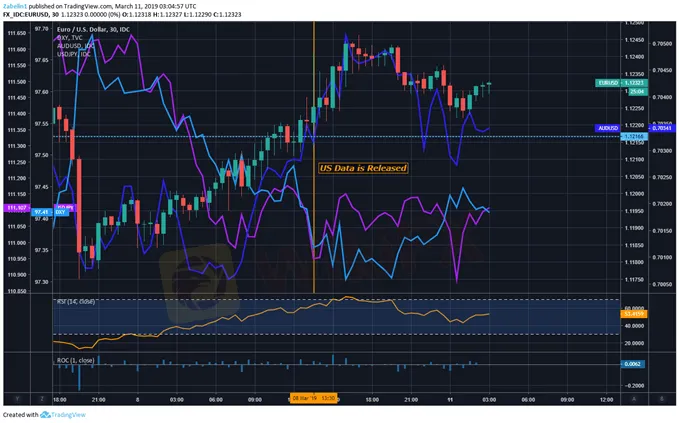简体中文
繁體中文
English
Pусский
日本語
ภาษาไทย
Tiếng Việt
Bahasa Indonesia
Español
हिन्दी
Filippiiniläinen
Français
Deutsch
Português
Türkçe
한국어
العربية
EUR/USD Shrugs Powell Interview - Eyes German Data, US Retail Sales
Abstract:After being battered by the ECB, EUR/USD will be watching todays release of German industrial production and US retail sales data.
TALKING POINTS – EUR/USD, US RETAIL SALES, GERMAN INDUSTRIAL ORDER
US retail sales may give EUR/USD boost
Will German industrial production falter?
Muted market response to Powell interview
See our free guide to learn how to use economic news in your trading strategy!
The Euro was battered last Thursday after the ECB not only decided to hold rates but subsequently introduced new liquidity provisions in an effort to counter slower-than-expected growth. The central bank also cut inflation forecasts for 2019, 2020 and 2021 while warning of greater geopolitical uncertainty. The upcoming European Parliamentary elections may soon put the Euro in the global spot light.
The following day – as expected – German factory orders undershot expectations. However, the response was relatively muted, likely as a result of the financial hangover caused by the ECB. On March 8, however, the pair was given a boost and offered a mild recovery to the exhausted Euro. US non-farm payrolls came in at 20K, significantly missing the 180K estimate and sent the US Dollar down against all its major counterpart
Earlier on March 10, Fed Chairman Jerome Powell was interviewed on 60 Minutes, but his comments did not elicit a strong market reaction. His commentary did not significantly deviate from his previous message of patience and vigilance on developments from abroad which may affect the US outlook e.g. China, Brexit.
German industrial production is expected to fall short of expectations as the largest Eurozone economy cools, and US retail sales may disappoint. Economic data coming out of the US for the past few weeks has been broadly missing estimates as the global economy slows down. If this trend continues, it may tilt the Fed to a more dovish angle to accommodate the economic circumstances and potentially push the US Dollar down.
Conversely, the US Dollar may gain as investors risk appetite sours and haven demand rises amid an uncertain outlook. The Greenback in this regard has a unique nature: it has the capacity to gain in times of risk aversion – even if the cause of uncertainty is coming from the US – and when local economic data outperforms. However, this time, the risk may not be directly emanating from home, but from abroad.
CHART OF THE DAY – DOLLAR SUFFERS AS US NON-FARM PAYROLLS DISAPPOINT

Disclaimer:
The views in this article only represent the author's personal views, and do not constitute investment advice on this platform. This platform does not guarantee the accuracy, completeness and timeliness of the information in the article, and will not be liable for any loss caused by the use of or reliance on the information in the article.
Read more

KVB Market Analysis | 28 August: Yen Strengthens on BoJ Rate Hike Hints; USD/JPY Faces Uncertainty
The Japanese Yen rose 0.7% against the US Dollar after BoJ Governor Kazuo Ueda hinted at potential rate hikes. This coincided with a recovery in Asian markets, aided by stronger Chinese stocks. With the July FOMC minutes already pointing to a September rate cut, the US Dollar might edge higher into the weekend.

KVB Market Analysis | 27 August: AUD/USD Holds Below Seven-Month High Amid Divergent Central Bank Policies
The Australian Dollar (AUD) traded sideways against the US Dollar (USD) on Tuesday, staying just below the seven-month high of 0.6798 reached on Monday. The downside for the AUD/USD pair is expected to be limited due to differing policy outlooks between the Reserve Bank of Australia (RBA) and the US Federal Reserve. The RBA Minutes indicated that a rate cut is unlikely soon, and Governor Michele Bullock affirmed the central bank's readiness to raise rates again if necessary to combat inflation.

KVB Market Analysis | 23 August: JPY Gains Ground Against USD as BoJ Signals Possible Rate Hike
JPY strengthened against the USD, pushing USD/JPY near 145.00, driven by strong inflation data and BoJ rate hike expectations. Japan's strong Q2 GDP growth added support. However, USD gains may be limited by expectations of a Fed rate cut in September.

KVB Market Analysis | 22 August: Gold Stays Strong Above $2,500 as Fed Rate Cut Hints Loom
Gold prices remain above $2,500, near record highs, as investors await the Federal Open Market Committee minutes for confirmation of a potential Fed rate cut in September. The Fed's dovish shift, prioritizing employment over inflation, has weakened the US Dollar, boosting gold. A recent revision showing the US created 818,000 fewer jobs than initially reported also strengthens the case for a rate cut.
WikiFX Broker
Latest News
Interactive Brokers Expands Access to Taipei Exchange
Simulated Trading Competition Experience Sharing
WinproFx Regulation: A Complete Guide to Its Licensing and Safety for Traders
Axi Review: A Data-Driven Analysis for Experienced Traders
INZO Regulation and Risk Assessment: A Data-Driven Analysis for Traders
Pepperstone CEO: “Taking Down Scam Sites Almost Every Day” Becomes “Depressing Daily Business”
The CMIA Capital Partners Scam That Cost a Remisier Almost Half a Million
Is Seaprimecapitals Regulated? A Complete Look at Its Safety and How It Works
eToro Cash ISA Launch Shakes UK Savings Market
Cleveland Fed's Hammack supports keeping rates around current 'barely restrictive' level
Currency Calculator



